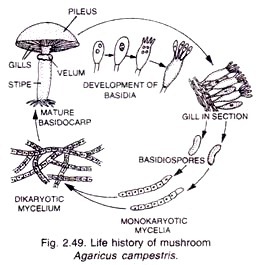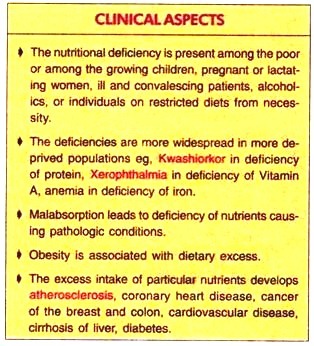ADVERTISEMENTS:
Let us make an in-depth study of the protein metabolism. After reading this article you will learn about the digestion and absorption process of protein.
Digestion and Absorption:
The major constituents of the food are carbohydrates, proteins and lipids. They are digested and absorbed in the stomach and intestine. Some of the digested/degraded components of the food stuffs may either be reutilized or may be excreted out. Chewing of food, movements of the stomach and intestine facilitate the grinding of the food materials and bring them in contact with gastric secretions.
Proteolytic enzymes are absent in the salivary secretions, hence there is no digestion of proteins in the mouth. Proteolysis takes place in the gastro-intestinal tract (i.e. stomach and intestine). When the proteins enter the stomach they stimulate the secretion of the hormone called gastrin which in turn stimulates the secretion of HCl by parietal cells of the stomach and pepsinogen from the chief cells.
ADVERTISEMENTS:
Gastric juice is acidic i.e. the pH is 1.5—2.5. Acidic pH of the stomach has an antiseptic action that kills the bacteria and other microorganisms. At this pH the dietary proteins also get denatured. In presence of HCl, pepsinogen is converted to pepsin by autocatalysis resulting in removal of some of the amino acids from the amino terminal end. Pepsin is an endopeptidase for tyr, phe, trp.
In the stomach the proteins are converted as follows:
Protein → Metaprotein → Proteone → Peptone → Peptide
As the food passes from the stomach to small intestine the low pH of the food triggers the secretion of the hormone ‘secretin’ into the blood. It stimulates the pancreas to secrete HCO3 into the small intestine in order to neutralize HCl. The secretion of HCO3 into the intestine abruptly raises the pH from 2.5 to 7.0. The entry of amino acids into the duodenum releases the hormone ‘cholecystokinin’ which in turn triggers the release of pancreatic juice (that contains many pancreatic enzymes like trypsinogen, chymotrypsinogen, procarboxypeptidases) by the exocrine cells of the pancreas (ecbolic and hydrolatic). Most of these enzymes are produced as zymogens (inactive enzymes) by the pancreas in order to protect the exocrine cells from being digested.
ADVERTISEMENTS:
Subsequent to the entry of trypsinogen into the small intestine it is activated to trypsin by enterokinase secreted by the intestinal cells. Trypsin is formed from trypsinogen by the removal of hexapeptide from the N-terminal end.
The newly formed trypsin activates the remaining trypsinogen, Trypsin is an endopeptidase, specific for (acts on) the peptide bonds contributed by the basic amino acids like arginine, histidine and lysine. Chymotrypsin is secreted in an inactive from called chymotrypsinogen which is activated by trypsin. Chymotrypsin is an endopeptidase specific to aromatic amino acids i.e. phenylalanine, tyrosine, tryptophan.
Carboxypeptidase secreted as procarboxypeptidase is activated again by trypsin. It is an exopeptidase that cleaves the amino acids from the carboxy terminal end. Amino peptidase secreted as pro-aminopeptidase is once again activated by trypsin. It is an exopeptidase that cleaves the amino acids from the free amino terminal end. Dipeptides acts only on dipeptides and hydrolyses it into 2 amino acids.
Even after the action of all these enzymes most of the proteins remain undigested. Protein like collagen, fibrin etc., escape digestion and are excreted out.
Celiac Disease:
This is a rare disease caused due to genetic defect/absence of the enzyme required to hydrolyze the proteins containing N-glutamyl amino acids. Due to this the intestinal enzymes are unable to digest the water insoluble proteins present in wheat called gliadin which is injurious to the cells lining the small intestine.
In rare instances the inactive zymogen forms of the enzymes stored in the pancreas are pre-matured to active forms in the pancreas itself, which may be fatal to the pancreas. Antagonists called trypsin inhibitor, a protein secreted by the pancreas can be used to avoid such disaster.
Absorption of the Digested Proteins:
There are four distinct carrier systems in the intestinal epithelium for the absorption of the digested proteins. These are:
ADVERTISEMENTS:
(1) Carrier system for neutral amino acids
(2) Carrier system for basic amino acids
ADVERTISEMENTS:
(3) Carrier system for acidic amino acids
ADVERTISEMENTS:
(4) Carrier system for glycine and imino acid (proline)
The digested amino acids are carried across the mucosal cell membrane from the intestinal lumen to the cytoplasm of the cell by one of the above carrier systems specific to that particular amino acid. Absorption of amino acids is an up-hill process (i.e. against gradient as compared to the Na+ absorption which is downhill i.e. along the gradient).
There are four systems that operate to absorb amino acids from the mucosal cells into the blood. They are:
(1) A — system (alanine system)
ADVERTISEMENTS:
(2) L — system (leucine system)
(3) Ly – system (lysine system)
(4) Ala-ser-cyst – system
Amino acids are taken up by the blood capillaries of the mucosa and are transported in the plasma to the liver. Some amounts of amino acids are also absorbed through the lymph. Glucagon stimulates the absorption of amino acids through ‘A’ system mediated by cAMP. Insulin stimulates the trans cellular transport of amino acids to minimize the loss in the urine. The proximal tubule cells reabsorb and return them to the blood stream. It is done by glutathione, a tripeptide. Three ATPs are utilized for the absorption of each amino acid.
ADVERTISEMENTS:
Absorbed amino acids do not stimulate antibody production whereas an intact protein absorbed becomes antigenic. Intestinal membranes allow the transport of proteins across them ex.—In a neonate the intestinal mucosa is permeable to y-globulin (immunoglobulin) of colostrum.
The immune system in a neonate is not well developed thus absorption of intact y-globulin into the blood does not elicit any immune response instead it results in the defence of the neonate against infections. In adults, some proteins may be absorbed intact through the intestinal mucosa leading to the formation of antibodies and anaphylactic reactions or other such immunological phenomena after the absorption of those proteins. Thus in such cases allergies to food proteins occur.
Protein Turnover:
Protein turnover is a continuous process of degradation and re-synthesis of all cellular proteins. Each day, human beings turn over 1 to 2% of their total body proteins i.e., about 2% of the body proteins are degraded and resynthesized every day. 75-80% of the amino acids released from the degraded proteins are reutilized for new protein synthesis and the nitrogen of the remaining 20-25% forms urea leaving the carbon backbone to be oxidized to intermediates of TCA or other metabolites.
The rate at which proteins degrade depends upon the physiological state of the individual. The time required to reduce the concentration of a given protein to 50% of its original concentration is termed as ‘half-life (t½)’. The half-life of liver proteins ranges from 30 minutes to 150 hours. The half-life of HMG CoA reductase is 0.5-2 hours whereas aldolase, lactate dehydrogenase and cytochromes have a half-life of 100 hours. Hence it can be said that, almost all the proteins of the body are degraded within a span of 6-9 months and are replaced by new proteins.
Role of Lysosomes in Protein Turnover:
Lysosomes play an important role in the degradation of intracellular and extracellular proteins. The proteins from the circulation and those within the cell lose the oligosaccharides and are then internalized by the lysosomes and are degraded by proteases called cathepsins. The non-glycosylated proteins are degraded in the cytosol by ubiquitin, a small protein of 8.5 kDa in all eukaryotic cells.
Ubiquitin forms a non-peptide bond with the N-terminal amino acid in the protein with conversion of ATP to AMP. Thus, the life of the protein depends upon the type of amino acid present at the N-terminal end. If serine and methionine are present as the N-terminal amino acid then the life of the proteins is long and if aspartate and arginine are present then the life is short because ubiquitin acts fast on these amino acids.


